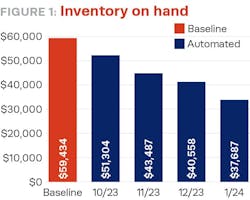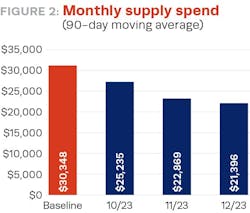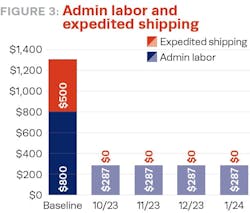Smart inventory cabinets: Can automated dispensing make a difference for the bottom line?
Throughout my career, I’ve had a front-row seat to the challenges and opportunities that face modern professional practices, and I’ve learned a lot about how to realistically make progress in solving them. At Affordable Care, the dental support organization (DSO) for Affordable Dentures & Implants, our team finally found a technology that could help solve two headaches for any DSO and dental practitioner—workflow efficiency and inventory.
Affordable Care has grown significantly during my tenure; however, the journey has not been without hurdles. Traditional pain points such as antiquated processes and bloated inventory levels have long plagued dental practices, often leading to unnecessarily high costs of goods sold (COGS) and strained operational efficiencies. Combine many practices within a DSO or not prioritize the problem in a dental practice for many years, and you compound the problem.
Last year, we conducted a couple of case studies to evaluate smart inventory cabinets from Zimbis, and we were very impressed with the results. We are now considering equipping a large portion of the organization with this technology. Here, we’ll share the results of these studies.
The problem of inventory management
In many dental practices, inventory management remains stuck in the past. Conventional systems involve manual counting, tracking, and reordering of supplies, which not only consumes valuable time but also increases the likelihood of errors. This can lead to either excess inventory, which ties up capital on shelves, or insufficient stock, which can disrupt the flow of services. This is especially painful for high-cost, revenue-critical items such as dental implants.
Furthermore, practices face ongoing challenges with regulatory compliance, particularly in tracking and managing lot numbers of implantable devices, and, of course, controlled substances.
The case studies in question identified specific challenges faced by Affordable Care’s supported dental practices, including:
Inefficient practice workflows: Time lost in manual inventory checks and administrative tasks that could otherwise have been spent on patient care
Excess inventory: Substantial capital locked up in unused supplies, affecting the practice’s financial health
High COGS: Elevated costs associated with maintaining and managing inventory, including emergency reordering and waste due to expired or misplaced items
Insights from the case studies
The introduction of smart inventory cabinets represented a significant leap toward addressing these inefficiencies. Dr. Louis Visser, Zimbis founder and president, is a dentist and former practice owner, so he understands the problems intimately, having “walked a mile in our shoes.”
The Zimbis cabinets themselves are designed to automate much of the inventory management process, from tracking usage to reordering supplies. They essentially expanded the dental practice staff footprint without having to hire additional employees; this has been the process of capital-A automation for a long time but largely hasn’t been well realized until now.
For the two practices we looked at—Affordable Dentures and Implants locations in Jackson, Mississippi, and Mesa, Arizona, the results were telling:
Significant reduction in on-hand inventory: These practices saw a reduction in the amount of capital tied up in supplies, shedding over $14,000 (Mesa) and $20,000 (Jackson) of excess inventory within the first four months of using Zimbis (figure 1).
Lower supply costs: Smarter, automated orders and “just in time” supply dropped monthly spending by $8,000–$10,000 at each practice (figure 2) in the first four months. After using excess inventory, monthly supply savings normalized to almost $2,500 a month.
Decrease in administrative labor and shipping costs: The Zimbis units reduced the time staff spent on inventory management, freeing them up for more patient-focused tasks. We measured these savings at nearly $1,000 per month in direct wage benefit, and much more through an opportunity cost lens (figure 3).
Improved regulatory compliance: With better tracking and automated logging, our practices could adhere more easily to regulatory requirements. It’s hard to put a price tag on sleeping better at night knowing that you are buttoned up.
These outcomes not only bolster the operational bottom line but also enhance clinical efficiency and patient satisfaction. The less time staff spend on back-end operations, the more dental teams can focus on what truly matters—patient care.
Moving forward
Investing in technologies such as smart cabinets can seem daunting at first due to upfront costs and the challenge of integrating new systems with existing workflows. But it’s manageable, and the Zimbis system we’re using is on a subscription model so it’s OPEX (operating expenses) rather than CAPEX (capital expenditures). The company was able to waive the upfront fees, so the system was cash-positive from day one. Any multilocation group or single practitioner looking at the placement of these types of systems should be able to drive a discount.
Conclusion
The positive outcomes we’ve seen with smart inventory cabinets at Affordable Care doesn’t guarantee your group will see identical results, of course, but they’ll likely be similar given that the challenges of workflow inefficiency and inventory/supply bloat are so widespread. There’s hardly a practice out there that couldn’t stand to trim a few thousand in inventory or improve the accuracy of their controlled drug logs. This technological shift is not just about keeping pace with industry trends but setting new standards that define what it means to run a modern dental practice.
The future of dental inventory and workflow is here, and it is smarter than it was yesterday. The best part—it will enable your dental practice to deliver exceptional care more efficiently than ever before.
Editor's note: This article appeared in the November/December 2024 print edition of Dental Economics magazine. Dentists in North America are eligible for a complimentary print subscription. Sign up here.
About the Author

Blake Hibray
President of Sevaredent Sourcing Solutions
Blake Hibray joined Affordable Care, LLC, in 2019 as vice president of supply chain and founded Sevaredent Sourcing Solutions, serving over 2,000 dental practices. Sevaredent is the largest GPO focusing on the DSO dental segment. Blake has extensive experience in supply chain management across industries, including dental, acute care, and life sciences. He has held executive roles in companies ranging from startups to a $2.7 billion global manufacturer. He holds a bachelor’s degree from Iowa State University.



